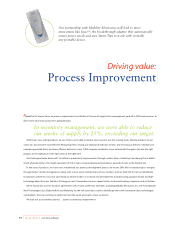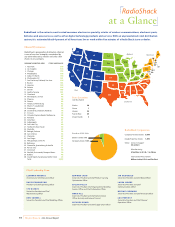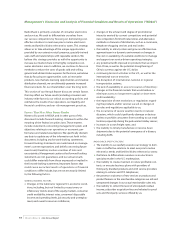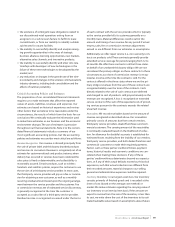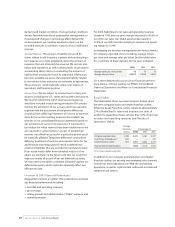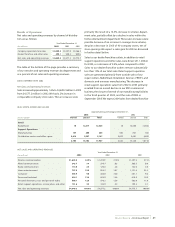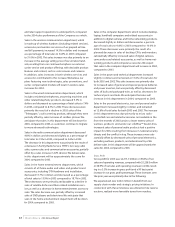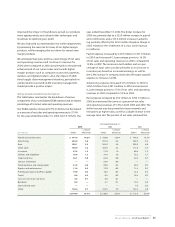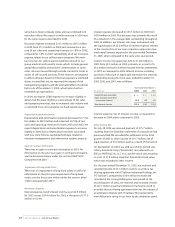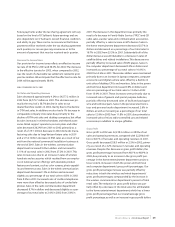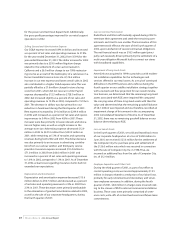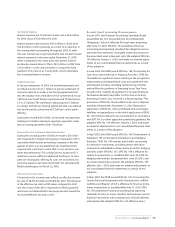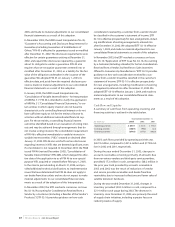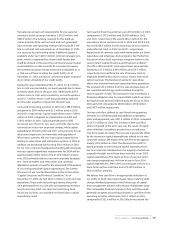Radio Shack 2003 Annual Report Download - page 21
Download and view the complete annual report
Please find page 21 of the 2003 Radio Shack annual report below. You can navigate through the pages in the report by either clicking on the pages listed below, or by using the keyword search tool below to find specific information within the annual report.
RADIOSHACK 2003 Annual Report 19
>the existence of contingent lease obligations related to
our discontinued retail operations arising from an
assignee’s or a sub-lessee’s failure to fulfill its lease
commitments, or from our inability to identify suitable
sub-lessees for vacant facilities;
>the inability to successfully identify and analyze emerg-
ing growth opportunities in the areas of strategic
business alliances, licensing opportunities, new markets,
alternative sales channels, and innovative products;
>the inability to successfully identify and enter into rela-
tionships with developers of new technologies or the
failure of these new technologies to be adopted by the
market; and
>any reductions or changes in the growth rate of the wire-
less industry and changes in the wireless communications
industry dynamics, including both consolidation and the
effects of number portability.
Critical Accounting Policies and Estimates
The preparation of our consolidated financial statements
requires us to make estimates that affect the reported
values of assets, liabilities, revenues and expenses. Our
estimates are based on historical experience and various
other factors that we believe to be reasonable under the
circumstances, the results of which form the basis for our
conclusions.We continually evaluate the information used
to make these estimates as our business and the economic
environment changes.The use of estimates is pervasive
throughout our financial statements.Note 2 to the consoli-
dated financial statements includes a summary of our
most significant accounting policies, but the accounting
policies and estimates we consider most critical are as follows:
Revenue Recognition: Our revenue is derived principally from
the sale of private label and third-party branded products
and services to consumers. Revenue is recognized, net of an
estimate for customer refunds and product returns, when
delivery has occurred or services have been rendered, the
sales price is fixed or determinable, and collectibility is
reasonably assured. Certain products, such as wireless
handsets and satellite systems, require the customer to use
the services of a third-party service provider. In most cases,
the third-party service provider will pay us a fee or commis-
sion for obtaining a new customer, as well as a monthly
recurring residual amount based upon the ongoing arrange-
ment between the service provider and the customer. Fee
or commission revenue, net of estimated service disconnects,
is generally recognized at the time the customer is
accepted as a subscriber of a third-party service provider.
Residual income is recognized as earned under the terms
of each contract with the service provider, which is typically
as the service provider bills its customer, generally on a
monthly basis. Material differences could result in the
amount and timing of our revenue for any period if actual
returns, sales, fee or commission revenue adjustments
exceed or are different from our estimates or assumptions.
Additionally, we offer repair service (i.e., non-warranty) con-
tracts on products sold.These contracts generally provide
extended service coverage for periods ranging from 12 to
60 months.We offer these contracts in all but three states
on behalf of an unrelated third-party obligor.We are not
considered the primary obligor on these contracts. In these
circumstances, our share of commission revenue is recog-
nized as income at the time the contract is sold. For the
contracts offered in the three states where we are the pri-
mary obligor, revenues from the sale of these contracts are
recognized ratably over the term of the contracts. Costs
directly related to the sale of such contracts are deferred
and charged to cost of products sold proportionately as the
revenues are recognized.A loss is recognized on extended
service contracts if the sum of the expected costs of provid-
ing services pursuant to the contracts exceeds the related
unearned revenue.
Receivables: We record receivables based on the amount of
revenue recognized as described above.Our receivables
primarily consist of amounts due from certain vendors,
third-party service providers, dealer/franchisees and com-
mercial customers.The carrying amount of the receivables
is continually evaluated based on the likelihood of collec-
tion. An allowance for doubtful accounts is established for
estimated losses resulting from the inability of our vendors,
third-party service providers, and both dealer/franchise and
commercial customers to make their required payments.
Factors such as these parties’ creditworthiness, payment
terms, historical results and economic conditions are con-
sidered when making these decisions. If any of these
parties’ creditworthiness deteriorates beyond our expecta-
tions, or if any of their actual defaults exceed our historical
experience, such that actual collections are different from
their recorded amounts, material charges to our selling,
general and administrative expenses could be required.
Inventory: Inventory is our largest asset class. Our inventory
consists primarily of finished goods and is recorded at the
lower of cost (based on the average cost method) or
market.We make estimates regarding the carrying value of
our inventory on an item-by-item basis. If the amount we
expect to receive from the sale of the inventory is less than
its cost, we write down the cost of the inventory to its esti-
mated realizable value based on assumptions about future



